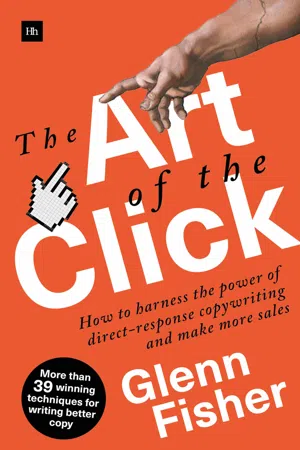
The Art of the Click
How to Harness the Power of Direct-Response Copywriting and Make More Sales
- English
- ePUB (mobile friendly)
- Available on iOS & Android
The Art of the Click
How to Harness the Power of Direct-Response Copywriting and Make More Sales
About This Book
Every business making sales online is engaged in a battle to get customers to click. More clicks equals more sales equals a more successful business. How do you write copy that will encourage more people to buy from you? How do you persuade customers over the line to make that final buying decision? What is The Art of the Click? The answer lies in the power of direct-response copywriting.In this entertaining and highly readable guide, copywriting expert Glenn Fisher boils down over a decade of experience to present a huge array of techniques, tactics and industry secrets to improve your copywriting, get more clicks... and ultimately, get more sales.You will discover:-- The single thing every great writer must do if they want to improve.-- How anyone can learn to write a headline that will stop all potential customers in their tracks.-- Where to find inspiration and how to feed ideas.-- How you can get a customer physically nodding along with every word you write.-- How to avoid waffle and make your copy more succinct.-- How you can write irresistible offers than no one can refuse.-- And much more!Pick up The Art of the Click now to improve your copywriting. You'll soon be wondering how you ever made a sale without it...
Frequently asked questions
Information
Table of contents
- Contents
- Praise for The Art of the Click
- About the author
- Preface
- Introduction: Direct-Response Copywriting in the Internet Age
- Part One: Before You Write A Word
- Chapter One: All Great Copywriters Start Here
- Chapter Two: The Importance of Rote Learning
- Chapter Three: Understanding Your Audience
- Chapter Four: Doing Your Research
- Chapter Five: The Importance of Good Ideas
- Part Two: Writing Copy
- Chapter Six: Features Versus Benefits
- Chapter Seven: Promise, Picture, Proof and Push
- Chapter Eight: Urgent, Useful, Unique and Ultra-Specific
- Chapter Nine: Writing Headlines
- Chapter Ten: Grabbing and Holding the Reader’s Attention
- Chapter Eleven: Salutations, Fellow Copywriter
- Chapter Twelve: The Importance of Narrative
- Chapter Thirteen: The Paradox of Testimonials
- Chapter Fourteen: Making An Offer
- Chapter Fifteen: If In Doubt, Cut It Out
- Chapter Sixteen: Time Management Tips for Writing Copy
- Chapter Seventeen: Sell, or Share?
- Part Three: The Interviews
- Chapter Eighteen: The King of Research
- Chapter Nineteen: The Million Dollar Man
- Chapter Twenty: A Friend from Down Under
- Chapter Twenty One: Psst… One More Thing
- Acknowledgements